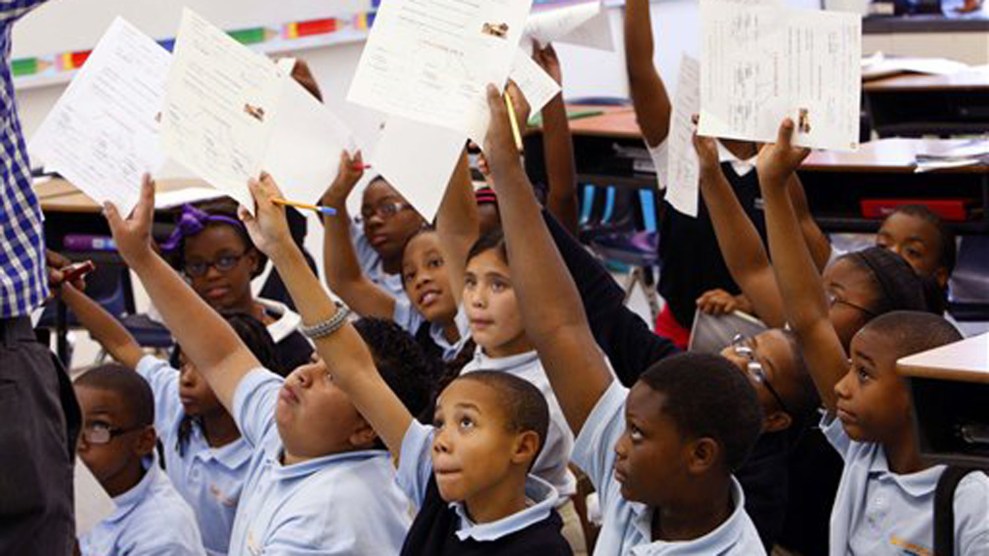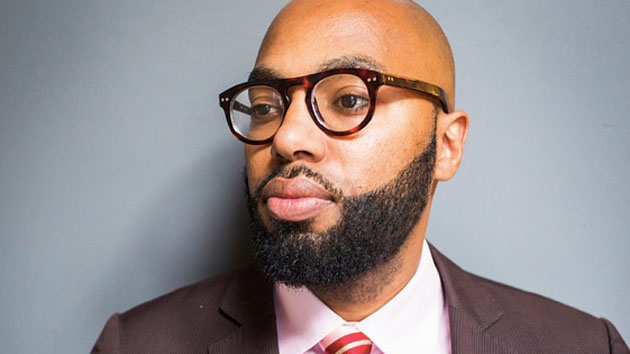
Students in a writing class at KIPP Memphis Collegiate Middle School in MemphisAlan Spearman/AP
A few weeks ago, the Movement for Black Lives, the network that also includes Black Lives Matter organizers, released its first-ever policy agenda. Among the organization’s six demands and dozens of policy recommendations was a bold education-related stance: a moratorium on both charter schools and public school closures. Charters, the agenda argues, represent a shift of public funds and control over to private entities. Along with “an end to the privatization of education,” the Movement for Black Lives organizers are demanding increased investments in traditional community schools and the health and social services they provide.
The statement came several weeks after another civil rights titan, the NAACP, also passed a resolution, calling for a freeze on the growth of charter schools. The NAACP had equated charters with privatization in previous resolutions, but this year’s statement—which will not become policy until the National Board meeting in the fall—represents the strongest anti-charter language to date, according to Julian Vasquez Heilig, a professor of education leadership and education chair of the NAACP’s California State Conference. “The NAACP is really concerned about unregulated growth of charter schools, and says it’s time to pause and take stock,” says Vasquez Heilig, who posted a copy of the resolution on his blog.
Such policy positions come at a time when parents, legislators, and philanthropists across the country—from Boston to Philadelphia to Los Angeles—are embroiled in fierce debates over the role of charters, particularly in poor, urban areas where most of these schools have been growing. Since 2000, the number of charters more than tripled, from about 1.7 percent to 6.2 percent of public schools.
Charter proponents—including prominent black educators like Secretary of Education John King Jr., Geoffrey Canada, and Steve Perry—argue that legislators need to continue this momentum for “choice” and competition among schools, citing the high test scores and college acceptance letters that many charter schools deliver. “We should not have artificial barriers to the growth of charters that are good,” King told reporters at the recent annual National Association of Black Journalists–National Association of Hispanic Journalists convention, adding that “charters should be a part of the public school landscape and can be a driver of opportunity for kids.”
Skeptics counter that charter schools contribute to racial and socioeconomic segregation, and that high percentages of charter school students in poor, urban districts can also contribute to the fiscal stress and the downward spiral of the traditional schools. Throughout the country, Vasquez Heilig noted, state charter laws vary dramatically: Some charter schools find ways to exclude disadvantaged children; others are created with explicit commitment to serve the most disadvantaged students. Vasquez Heilig argued that a moratorium would allow the public to investigate current practices and promote those that work the best.
“It’s time to pause and investigate: Should there be so many entities that are allowed to open them?” he said. “If you are not an educator, should you be allowed to open a charter school? Is there a due process for parents who feel that their kids were pushed out? How do charters schools make decisions about firing and hiring? How do they spend public money?”
Here are some of the most significant concerns charter school critics have cited over the years:
Some charter schools practice “skimming.” There is growing evidence that some charters accept only the least difficult (and that means the least expensive to educate) students. Earlier this month, a report by the ACLU Foundation of Southern California and the public interest law firm Public Advocates found that 1 in 5 California charter schools practice restrictive admissions requirements or other exclusionary practices—even though charter schools are required by law to admit all students who wish to attend. Some of these practices included denying enrollment to students with lower grades or test scores; expelling students who struggle academically; or requiring students and parents to write essays and go through admission interviews.
Researchers at the University of California-Los Angeles’ Center for Civil Rights Remedies also expressed similar concerns when they noticed a national pattern in their 2016 study: Some charters had both high test scores and very high suspension rates, they noted, prompting the authors of the report to conclude, “Although beyond the scope of this report, the possibility certainly exists that some charter schools are artificially boosting their test scores or graduation rates by using harsh discipline to discourage lower-achieving youth from continuing to attend.”
Meanwhile, traditional schools tend to educate students with greater challenges that cost more. One study in Philadelphia, for example, found that students with severe needs—those who have been in foster care, involved with the juvenile justice system, or whose families are on welfare—are concentrated in traditional public schools in Philadelphia. Traditional schools in Philadelphia also educate 10 percent more students living in poverty, 4 percent more English learners, and 2 percent more students with special needs.
Unregulated growth and lack of strong oversight. In June, the New York Times published a scathing investigation of Detroit’s school district, which has a bigger share of students in charters than any other city except New Orleans. Reporter Kate Zernike concluded, among many other findings, that insufficiently regulated growth—including too many agencies that are allowed to open new charter schools—contributed to a system with “lots of choice, with no good choice”:
The unchecked growth of charters has created a glut of schools competing for some of the nation’s poorest students, enticing them to enroll with cash bonuses, laptops, raffle tickets for iPads and bicycles. Leaders of charter and traditional schools alike say they are being cannibalized, fighting so hard over students and the limited public dollars that follow them that no one thrives. Michigan leapt at the promise of charter schools 23 years ago, betting big that choice and competition would improve public schools. It got competition, and chaos.
Other districts and states with high percentages of students in charter schools have come under similar criticism. In April, the general auditor of Pennsylvania published a report concluding that the state’s charter laws are the “worst in the US,” contributing to questionable financial practices in some charters in the district of Philadelphia, as well as fiscal woes in the state’s largest school district.
Unregulated explosion of charters drains money from traditional public schools. In most districts, per-pupil money follows students, but many expenses, such as building costs, salaries for teachers, and principals don’t go away when a student leaves for a charter school. Students in charter schools can also create extra costs. In Philadelphia, for example, the district has to pay for transportation for students attending charter schools that are often not in their neighborhood. The city also found that 30 percent of all charter students come from outside the district, but the city still has to pay for their education. As a result, a study by the Boston Consulting Group estimated that each new student in a charter school in Philadelphia creates as much as $7,000 in additional costs for the district.
Charter schools suspend more black students and children with disabilities. This year, UCLA’s Center for Civil Rights Remedies published a study that for the first time looked at the numbers of “out-of-school” suspensions for 5,250 charter schools and 95,000 public schools. The researchers found that while overall suspension rates have been going down since 2012, in charter schools, black students and students with disabilities were suspended at higher percentages in all grades than their peers in traditional schools. In middle and high schools, 12 percent more students with disabilities and 2.5 percent more black students were suspended in charters compared with noncharters.
Paying attention to this data is important, because researchers have found that being suspended is a strong indicator that a student will eventually drop out. And students who drop out are much more likely to end up in prison, becoming part of the “school-to-prison pipeline.” This issue disproportionately affects black students (in charter and noncharter schools), who are suspended at a rate four times greater than white students.
















